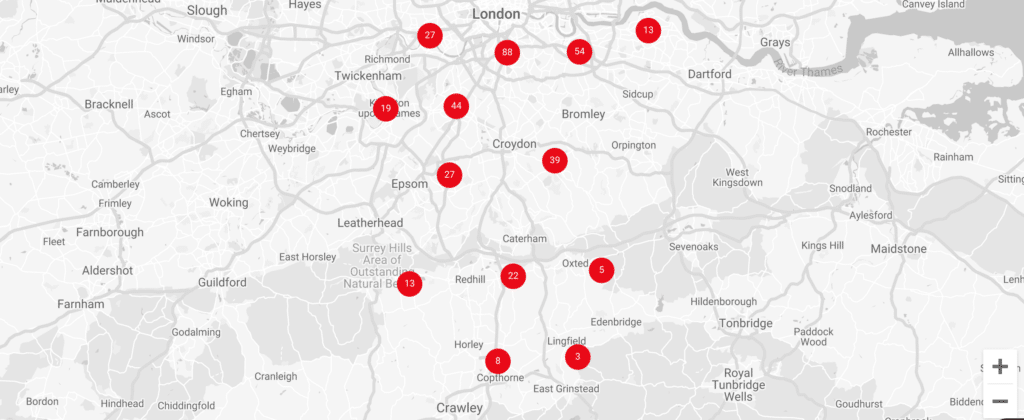Useful information
Patron
The Bishop
Episcopal Area
Croydon Episcopal Area
Deanery
Tandridge Deanery
Archdeaconry
Reigate Archdeaconry
Details of the Church
Built
C13/1832
Architect
Not Known
Listing
NL
That there has been a church on the site of the present St. Agatha’s for many hundreds of years is without question. The recorded history of the Parish begins with the Domesday Book (1080). “in Tenrige Hundred – Domesday, Tab IX. John holds of Richard (de Tonbridge) Wallingham … ‘ ” (Wallingharn, authorities now agree, refers to Woldingham and the family of “John” took the name de Wauton, or Walton).
At that time the population was about 39 distributed over the two farms known later as the Manor of Upper Court Lodge and the Manor of Nether Court Lodge.
For about 700 years these two manors with their two cottages were apparently the only dwelling houses; and, throughout that period of the history of the Parish, the history of the varied titled persons who held as part of their estate one or both of these manors, was the story of Woldingham. In the inquisitions made on the decease of the various holder we find occasional references to the advowson of the Chapel of Woldyngham. And so in 1296 on the inquisition on the death of Gilbert de Clare, it was found that the advowson of the Chapel belonged to him, and that it was of the value of 20 shillings. There is also reference in 1363 to a Robert Bonere, Parson of Wallingham, who was concerned with others in the conveyance of the Manor of Nether Court.
The recorded list of Rectors begins with the year 1308, but there are occasional gaps in the list as the registers for certain years are lost.
John Evelyn, (the famous diarist), records in his diary in 1677 that he was greatly grieved “about an old desolate dilapidated Church”, (that is, Woldingham Church), “standing on the hill above the house” which, he says, he left Sir Robert Clayton of Marden Park in good disposition to repair, “there not being above foure or five houses in the Parish besides that of this prodigious rich Scrivener.”
Of the church at that time Manning wrote that it “stands by itself in a wood distant from any house, and consists of one room about 10 yards long and 7 wide, divided into two parts by a wooden screen, without any Tower, Spire or Bell. It is built with flints and some white free stone of the country intermixed. The North Side is very rude work, the South Side more regular. It is tiled. The only window in the East has been large, a semi-circular arch, but the upper part is now filled up with bricks; the lower part is of diamond shaped glass, about 4 yards long, and one high.
In the east division of the church are four open seats on the South Side, and two pews on the North, with a small pulpit. In the other division is a stone seat against the West and North Walls.”
In 1832 this church was replaced by one built by Mr G F Jones, and this building was greatly restored in 1889 by Sir Walpole Greenwell and remains much the some to this day. Before its restoration those who saw the church in 1832 describe it as a quaint place without a chancel. A stove stood in the centre and a flue passed through the roof. A square pew occupied the south east corner
The restored church was reopened on October 20th 1889 by the lord Bishop of Rochester (Woldingham at that time being part of the Rochester Diocese).
The name of the ancient church is not certain but the name of the church built in 1832 is known to have been St. Agatha’s, and this name has remained all through the ensuing years as its title. After restoration, the seating accommodation was and still is only about 40, and it continued to be the Parish Church of Woldingham until 1934 when the new church of St Paul was consecrated.
There are still evidences, although scant, of St. Agatha’s links with the past. There is a Monumental inscription in the floor of the aisle which reads, ‘Here lieth the body of Richard Glover, Yeoman, of this Parish who died the 19th March 1 772 aged 68 years”. Let into the wall of the back of the Church is what can only have been a Piscina, (used for washing the sacred vessels after use at Holy Communion), and now used as the Font for the Church. In the Churchyard, on a tomb, we find, ‘Here lyeth the body of Richard Hayward, of this parish, yeoman, who died October the 14th 1731, aged 61 years. Also the body of Alice Hayward, widow of the above named Richard Hayward who died the 19th day of November 1 731 aged 78 years.
The fine stained-glass east windows, designed and executed by Septimus Waugh in 1994, depict “Christ the Healer”. They were given in memory of Dr Tertius Watson, a homeopath, who resided in Woldingham for many decades and whose remains are buried in the churchyard.
The churchyard of St Agatha’s has been the resting place for the inhabitants of Woldingham for many hundreds of years and it remains today “the Churchyard” in spite of no longer being the Parish Church of Woldingham.




